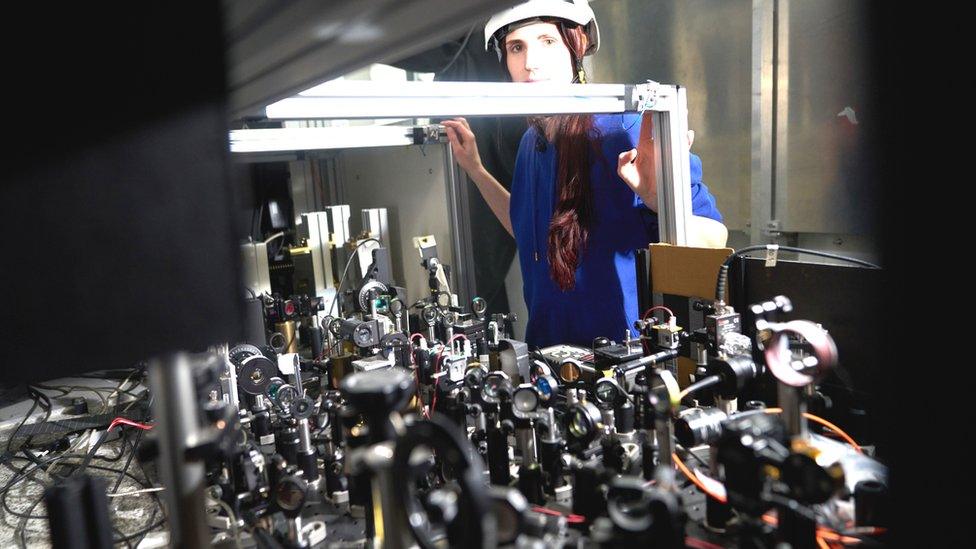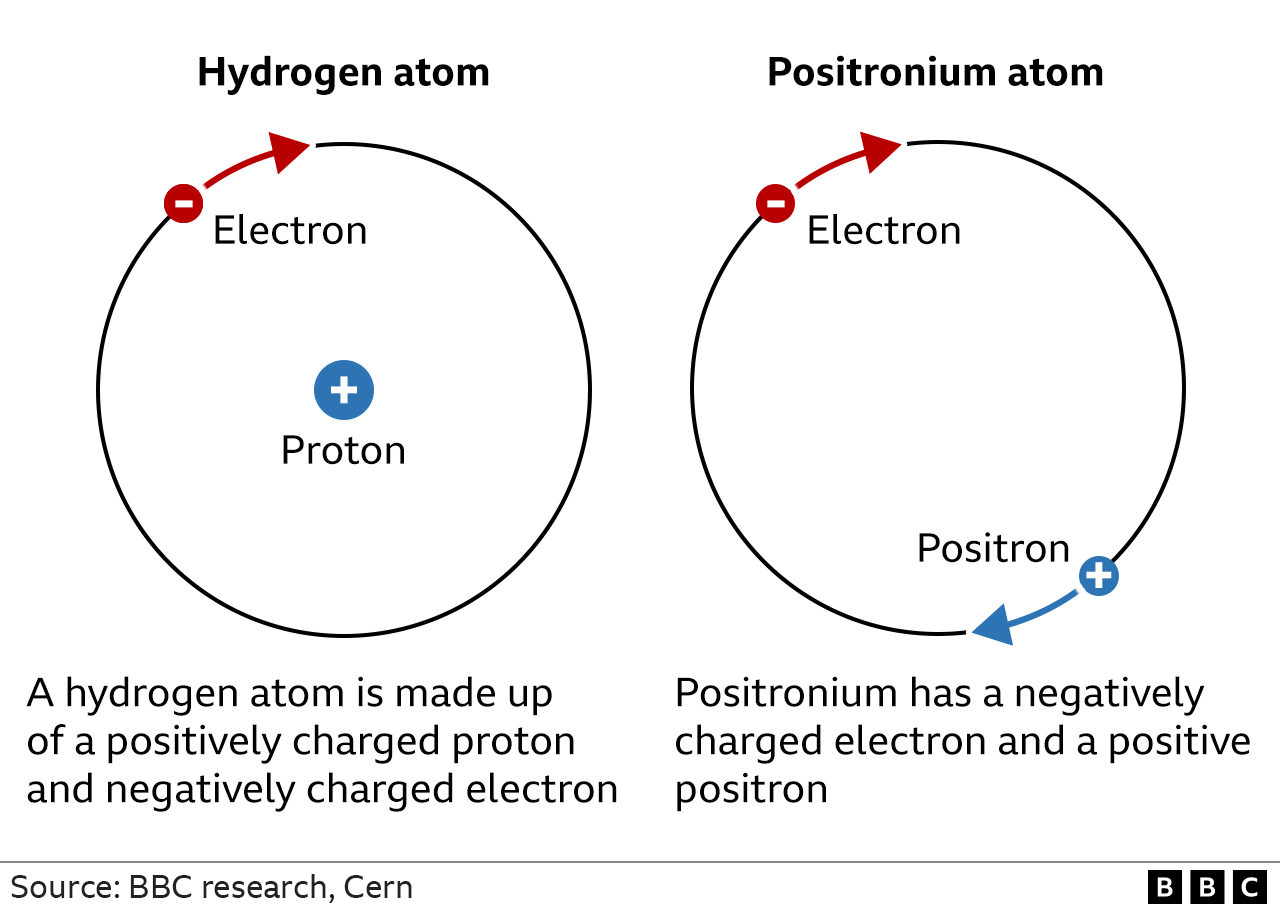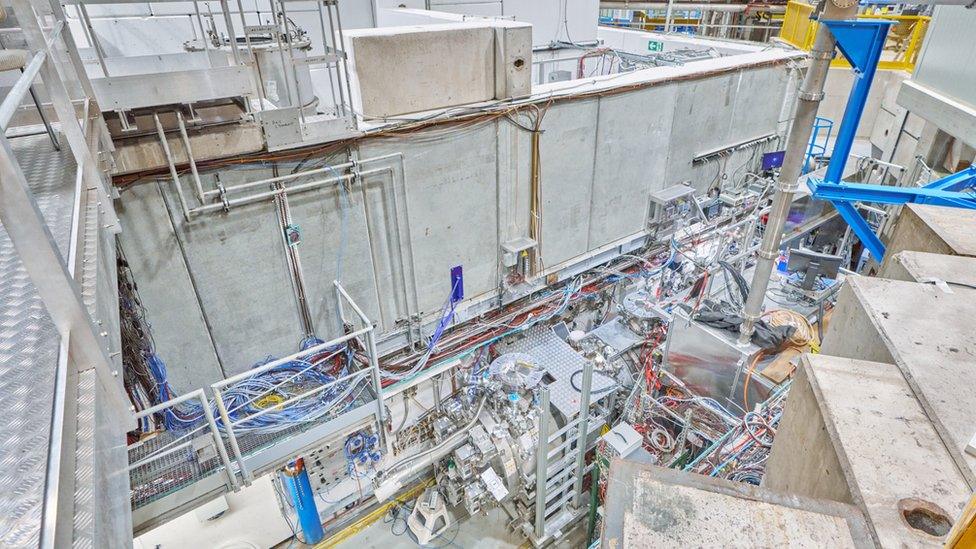Antimatter: Scientists freeze positronium atoms with lasers
- Published

Lisa Gloggler was among those who set up an intricate system of lasers to cool positronium atoms
It's extremely rare and usually exists for just 142 billionths of a second.
Positronium can generate huge amounts of energy. It can shed light on 'antimatter' which existed at the beginning of the Universe, and studying it could revolutionise physics, cancer treatment, and maybe even space travel.
But until now the elusive substance has been almost impossible to analyse because its atoms move around so much.
Now scientists have a workaround - freezing it with lasers.
"Physicists are in love with positronium," said Dr Ruggero Caravita, who led the research at the European Organisation for Nuclear Research (Cern), near Geneva. "It is the perfect atom to do experiments with antimatter."
"Now the entire field of study is unblocked."
So what exactly is positronium?
It is a so-called exotic atom consisting of both matter and antimatter - so very unusual stuff indeed.
Matter is what the world around us is made from, including the stars, the planets and us.
Antimatter is its opposite. It was created in equal amounts when the Universe was born but exists only fleetingly in nature now, with very little of it occurring naturally in the cosmos.
Discovering why there is now more matter in the Universe now than antimatter - and therefore why we exist - will take us a long way toward a new, more complete theory of how the Universe evolved, and positronium could be the key, according to Lisa Gloggler, a PhD student working on the project.
''Positronium is such a simple system. It consists 50% of matter and 50% of antimatter,"she said. "We are hoping that if there is any difference between the two we can see it more easily than in more complex systems."
One of the first experiments frozen positronium could be used for is to see if its antimatter part follows Einstein's Theory of General Relativity in the same way as the matter part.
The diagram below shows why positronium is so unique.

The matter, which forms the world around us, consists of atoms, the simplest of which is hydrogen, which is the most plentiful element in the Universe. This is made up of a positively-charged proton and a negatively-charged electron.
Positronium, on the other hand, consists of an electron and its antimatter equivalent, a positron.
It was first detected by scientists in the US in 1951. But it has been difficult to study because the atoms move around a lot because it is the lightest known atom.
But cooling it slows the atoms down, making it easier for scientists to study.
Up until now the coldest temperatures for positronium in a vacuum has been around 100C. The Cern team has now brought that down to more than -100C, using a technique called laser cooling. It is a difficult and intricate process where laser light is shone at the atoms to stop them jiggling about so much. The research has been published in the scientific journal Physical Review Letters.
For it to become usable for research positronium has to be frozen yet further, to around -260C, but the laser approach has given researchers a way forward, according to Prof Michael Charlton, an expert in positronium at Swansea University, who was not involved in the current breakthrough.
"This is a very encouraging first step, he told BBC News. "It is opening the door so you can see the light on the other side, beckoning you to a new era of positronium physics."

Positronium is created and cooled at Cern's antimatter factory
And the Cern group is not alone in their quest for frozen positronium. A group from the KEK Slow Positron Facility in Tokyo are about to publish similar results.
It is turning out to be a scientific race, involving other groups around the world as well, because this esoteric substance potentially has enormous practical benefits. When an electron and positron combine, they release huge amounts of energy. This could be harnessed to create powerful, so called gamma ray lasers.
Interstellar travel
Some applications are medical imaging, cancer treatments, some even talk of it as a means of propelling spacecraft close to the speed of light, making interstellar travel feasible in the far future.
The work was carried out at Cern's antimatter factory, which has recently created and stored the largest amount of antimatter hydrogen atoms in the known Universe.
Last year a separate team of researchers tested whether antihydrogen responded differently to gravity by seeing if it fell up or down when dropped. They found that they fell downwards, but they do not yet know if they fall down at the same rate as normal hydrogen.
Follow Pallab on X, external, formerly known as Twitter
Related topics
- Published27 September 2023

- Published5 February 2024
